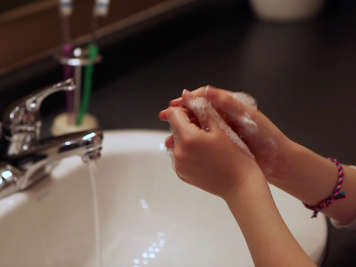
How can I prevent my child from getting an infection?
- Always wash your hands properly.
- Have a smoke-free home.
- Ask visitors to stay away if they are sick (for example, if they have a cough, fever or runny nose).
- Make sure anyone who is sick – but needs to be around your child to help care for them – cleans their hands often.
- If the person needs to cough, sneeze or touch their face, they should step away from your child and turn their head to avoid coughing or sneezing on your child or anything in your child’s immediate environment.
- Before the person returns to your child's side, they should clean their hands.
- Keep your child’s stoma and surrounding dressings clean and dry.
- Clean equipment regularly.
- Provide good mouth and dental care for your child. Good dental care can prevent infections that affect the entire body.
When should I wash my hands?
Wash your hands:
- before and after every suction
- before and after every tracheostomy tube change
- before and after stoma care
- after handling dirty equipment
- when your hands are dirty, especially if you can see dirt
- before, during and after you prepare food
- before you eat, feed a child or give medication
- after you use the bathroom
- after you change your child’s diaper or help them use the bathroom
- after you touch blood or other body fluids such as saliva, vomit and/or mucus
- after sneezing, coughing or blowing your nose
- after you touch animals or pick up their waste
- after you handle garbage.
Precaution
You will need to wash your hands more frequently when somebody is sick in your home.
How should I wash my hands?
- Wet your hands thoroughly with warm water.
- Apply enough liquid, foam or clean bar soap to cover the entire surface of the hand (the palm and the back).
- With your hands away from the water, rub your hands vigorously together.
- Scrub all surfaces.
- Make sure to get between the fingers and under the fingernails.
- Wash the wrists and lower arms, if necessary.
- Continue for at least 15 seconds or about the length of time it takes to hum a short song such as Happy Birthday twice. Both the soap and the scrubbing action help dislodge and remove germs.
- Rinse well, removing all soap residue.
- Dry your hands on a clean towel or paper towel.
- Use the towel to turn the tap off.
Can I use hand sanitizer instead of soap and water?
Yes, you can use hand sanitizer if your hands are not wet, greasy or visibly dirty. To make the hand sanitizer effective against germs, make sure that it contains at least 70 per cent alcohol (ethanol or isopropyl alcohol (isopropanol)).
Although hand sanitizer can be more convenient at times, use soap and water if your hands are wet, greasy or visibly dirty.
Precaution
Be careful when using hand sanitizer.
- Always supervise small children when using hand sanitizer.
- Do not leave hand sanitizer where small children might be able to drink it. (By volume, hand sanitizer contains 50 per cent more alcohol than most brands of vodka.)
- Rub your hands together until they are completely dry.
- Do not put your hands near a spark, flame or source of static electricity while they are still wet with hand sanitizer. The alcohol in the hand sanitizer can catch fire and cause injury.
How else can I prevent infection?
You can also prevent infection by following good mouth care guidelines.
Good mouth care:
- prevents infections that could spread to the rest of the body
- reduces the risk of future dental problems such as cavities and gingivitis.
Some families have a particularly strong strain of mouth bacteria or higher levels of bacteria that can lead to more tooth decay. If tooth decay is a problem in your family, be extra careful when cleaning your child’s teeth.
How do I provide good mouth care for my child?
Cleaning your child’s mouth
- Wipe a newborn baby’s gums with a soft, clean, damp cloth after feeding.
- At age three months, begin cleaning your child’s mouth after every feeding with a clean, damp washcloth.
Tooth brushing
- As soon as your child’s teeth poke through the gums, you and your child should clean them with a toothbrush.
If your child is aged under three
- If your child is under three years old, you will need to brush their teeth. Your child will be able to start, but you should complete their tooth brushing until they can tie their own shoelaces or cut food with a knife and fork on their own.
- If your child is under three and not at risk of tooth decay, you can clean their teeth with a toothbrush moistened with water.
- If they are at risk of tooth decay, use only a tiny amount of fluoride toothpaste (less than the size of a grain of rice). Ask your doctor or other health professional if your child is at risk.
If your child is aged three and older
- If your child is at a typical stage of development for a child aged three and older, they can usually brush their own teeth with your help and supervision. You should teach them “2 for 2” by this stage. This means brushing twice a day for two minutes each time, while you supervise them.
- Between the ages of three and six, your child can use a pea-sized amount of fluoride toothpaste.
Flossing
Get your child to start flossing early. In most cases, it is a good idea to start when your child's back teeth touch each other. This usually occurs around age three. Flossing is important because a toothbrush cannot clean between teeth.